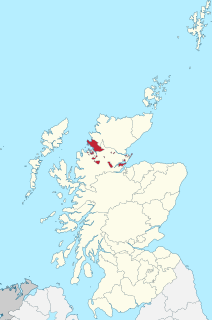Culross in Perthshire was a royal burgh that returned one commissioner to the Parliament of Scotland and to the Convention of Estates.
Kintore in Aberdeenshire was a royal burgh that returned one commissioner to the Parliament of Scotland and to the Convention of Estates.
Nairnshire was a constituency of the Parliament of Scotland before the Union with England in 1707. The barons of the shire or sheriffdom of Nairn elected two commissioners to represent them in the Parliament and in the Convention of Estates.
Forres in Elginshire was a burgh constituency that elected one commissioner to the Parliament of Scotland and to the Convention of Estates.
Dingwall in Ross-shire was a burgh constituency that elected one commissioner to the Parliament of Scotland and to the Convention of Estates.
Before the Act of Union 1707, the barons of the sheriffdom or shire of Dumfries and the stewartry of Annandale elected commissioners to represent them in the unicameral Parliament of Scotland and in the Convention of Estates. The number of commissioners was increased from two to four in 1690.
Before the Act of Union 1707, the barons of the shire of Bute elected commissioners to represent them in the unicameral Parliament of Scotland and in the Convention of Estates. After 1708, Buteshire and Caithness alternated in returning one member the House of Commons of Great Britain and later to the House of Commons of the United Kingdom.
Before the Act of Union 1707, the barons of the shire or sheriffdom of Caithness elected commissioners to represent them in the unicameral Parliament of Scotland and in the Convention of Estates. After 1708, Caithness alternated with Buteshire in returning one member the House of Commons of Great Britain and later to the House of Commons of the United Kingdom.
Anstruther Easter in Fife was a royal burgh, created in 1583, that returned one commissioner to the Parliament of Scotland and to the Convention of Estates.
Before the Acts of Union 1707, the barons of the shire of Elgin and Forres elected commissioners to represent them in the unicameral Parliament of Scotland and in the Convention of the Estates.
Before the Acts of Union 1707, the barons of the shire of Selkirk elected commissioners to represent them in the unicameral Parliament of Scotland and in the Convention of the Estates.
Before the Acts of Union 1707, the barons of the shire or sheriffdom of Argyll elected commissioners to represent them in the unicameral Parliament of Scotland and in the Convention of the Estates. The number of commissioners was increased from two to three in 1693.
Before the Acts of Union 1707, the barons of the shire of Stirling elected commissioners to represent them in the unicameral Parliament of Scotland and in the Convention of the Estates.
Before the Acts of Union 1707, the barons of the shire of Roxburgh elected commissioners to represent them in the unicameral Parliament of Scotland and in the Convention of the Estates. The number of commissioners was increased from two to four in 1690.
Before the Acts of Union 1707, the barons of the shire of Aberdeen elected commissioners to represent them in the unicameral Parliament of Scotland and in the Convention of the Estates. The number of commissioners was increased from two to four in 1690.
Before the Acts of Union 1707, the barons of the shire of Ross elected commissioners to represent them in the unicameral Parliament of Scotland and in the Convention of the Estates.
Before the Acts of Union 1707, the barons of the shire of Inverness elected commissioners to represent them in the unicameral Parliament of Scotland and in the Convention of the Estates.
Before the Acts of Union 1707, the barons of the shire of Dumbarton elected commissioners to represent them in the unicameral Parliament of Scotland and in the Convention of the Estates.
Before the Acts of Union 1707, the barons of the shire of Peebles elected commissioners to represent them in the unicameral Parliament of Scotland and in the Convention of the Estates.
Before the Acts of Union 1707, the barons of the shire of Perth elected commissioners to represent them in the unicameral Parliament of Scotland and in the Convention of the Estates. The number of commissioners was increased from two to four in 1690.

